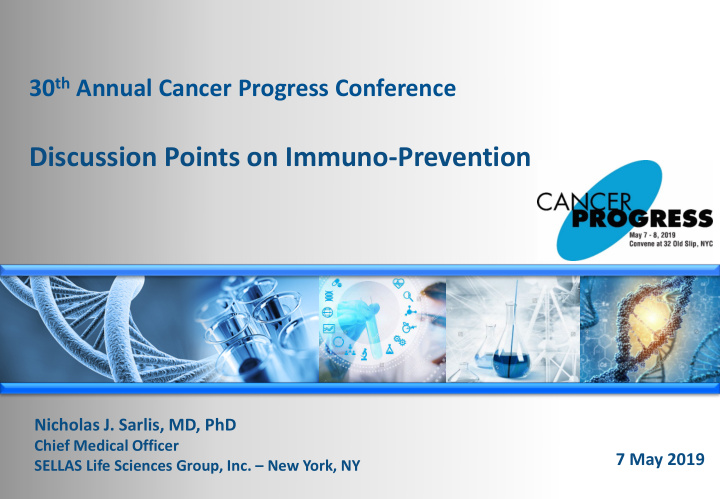



30 th Annual Cancer Progress Conference Discussion Points on Immuno-Prevention Nicholas J. Sarlis, MD, PhD Chief Medical Officer 7 May 2019 SELLAS Life Sciences Group, Inc. – New York, NY
LEGAL NOTICE • This presentation was prepared by Dr. Nicholas Sarlis in his personal capacity. • The opinions expressed in this presentation and associated panel discussion are the presenter’s/discussant’s own and do not reflect the view of Sellas Life Sciences Group, Inc. (SELLAS) • No confidential/ non-public data have been used in this presentation. COI DISCLOSURE • Dr. Sarlis is an Officer of SELLAS and holds equity in the company. • He also holds shares of Sanofi and Incyte Corp. 2
SECONDARY PREVENTION IN CANCER • Implementation of therapeutic modalities in the maintenance/ consolidation or adjuvant setting to prevent or delay the recurrence/relapse of disease after successful prior debulking • This could be in the context of local/regional and/or distantly metastatic disease; however, it is typically for the latter • Monotherapy vs. combination Rx Can be implemented after 1 st , 2 nd , 3 rd , …n th line of therapy (depending on the • tumor type and degree of unmet medical need) • Potential for prolonged periods of administration (if effective) • Ideally should be associated with: • low/manageable toxicity burden and • lack of appreciable tumor ‘escape’ from its therapeutic effect 3
Prolongation of Progression-Free Interval (PFI) should lead to improved Overall Survival (OS) OS w/o 2 o Prevention UF Initial Terminal P1 1L P2 2L P3 Diagnosis Disease Rx Adv. Dis. UF Initial Terminal P1 P2 1L 2L P3 Diagnosis Disease Rx Adv. Dis. OS w/ 2 o Prevention ∆ (OS) = Survival Benefit UF Rx: upfront therapy; 1L: first line (for advanced disease); w/: with; w/o: without; 4 2L: second line; P1,2,3: progression episodes 1,2,3; Adv. Dis.: advanced disease
SECONDARY PREVENTION IN CANCER Types of Agents Used: • Chemotherapy • numerous regimens in lymphomas, Stage 3 NSCLC/CRC, etc. • Radiobiologics • 131-I (radioiodine) in thyroid Ca • Targeted biotherapy • VEGF inhibitors in mesothelioma; PARP inhibitors in ovarian Ca; EGFR inhibitors (SCCHN); Endocrine therapy (Prostate/BrCa); assorted TKIs, etc. • Novel pathways: Tumor metabolic reprogramming (OxPhos inh); microbiome alteration, etc. • Immuno-Oncology (IO) Agents & Tumor Microenvironment (TME) Modulators • Interferon & Cytokines (renal Ca, melanoma) • Stem Cell Transplant (autologous in myeloma, allogeneic in AML, etc.) • Immune synapse modulators (Checkpoint blockade, etc. in melanoma and other tumor types) and other IO agents (e.g., bispecific antibodies, TILs, CAR T-cells, etc.) • Peritumoral inflammation modulators (JAK inh, IDO/TDO inh, etc.) • Cancer therapeutic vaccines 5
PARADIGMS OF USAGE OF CANCER VACCINES • AS MONOTHERAPY IN THE MAINTENANCE/ADJUVANT SETTING ADMINISTRATION OF VACCINE Lack of demonstrable UPFRONT TUMOR tumor burden: • Destroys residual tumor cells DEBULKING Complete Remission (CR) • Provides ongoing immuno-surveillance or Minimal Residual • Chemotherapy against recurrent tumors Disease (MRD) in hem • Targeted Therapy • Mitigates against tolerance malignancies • Radiation therapy • Destroys both proliferating and cancer NED Status in Solid • Surgery stem cells and prevents recurrence Tumors • IN COMBINATION WITH OTHER THERAPIES (MAINLY IMMUNOTHERAPIES) TO TREAT MEASURABLE/ MACROSCOPIC ADVANCED DISEASE • Clinical trials studying the effect of the combination of cancer vaccines plus immuno-oncology (IO) agents vs. IO agents alone • Strong preclinical/ immunobiological rationale (in most cases) 6
TYPES OF CANCER VACCINES • Antigen vaccines • Protein/ Peptide vaccines • Vaccines against other types of molecules (e.g., glycolipids) • Whole cell vaccines • Autologous • Allogeneic • Dendritic cell (DC) vaccines • incl. ex vivo modified DC vaccines • DNA vaccines • Anti-idiotypic vaccines 7
PEPTIDE VACCINES – CHALLENGES & OPPORTUNITIES • Ability to ‘address’ a large variety of antigenic targets (incl. intranuclear proteins) • Valency/ “Spectrum” • “Wide-spectrum” vaccines (multivalent): • E.g.: Galinpepimut-S (anti-WT1) – tetravalent wide variety of tumor types express the target antigen • “Narrow-spectrum” vaccines: • E.g.: Nelipepimut-S (anti-HER2) – monovalent, E39/J69 (anti-Folate binding protein) - bivalent • Heteroclitic technology • By design mutated residues (cross-reactive with native fragment) • Improved antigenicity/ immunogenicity • Decreased tolerance • “Off-the-shelf”, relatively low manufacturing costs; low toxicity burden (no ‘off-target’ effects) • Need for prestimulation with immune adjuvant (GM-CSF) • Ideally, need to stimulate both CD8+ and CD4+ T-cells • “Epitope spreading” is a highly desirable attribute and a biomarker of immunologically mediated cancer cell death • Ideally, ability to be applied in a global scale (across HLA types; MHC Class I and II binding) • Opportunity for inoculation boosters (~q.3-6 months) over long time periods 8
CANCER VACCINES: MECHANISM OF ACTION & EXPECTED OUTCOMES 9 Finn OJ . J Immunol ., 2018
Recommend
More recommend